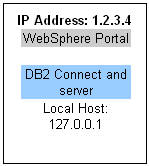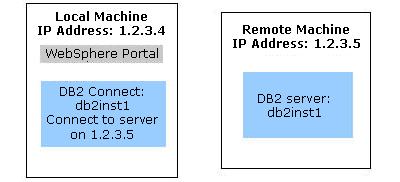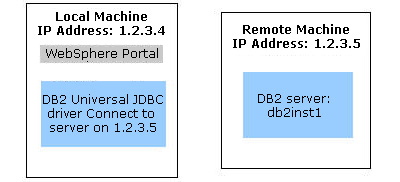Planning for DB2 on UNIX or Linux
When planning to transfer data to IBM DB2 Universal Database™ Enterprise Server Edition, you should consider the databases and user information, such as database names, what data is stored, and the database space needed. Some fix packs require steps prior to the transfer task to complete successfully. Before you begin:
- WebSphere Portal supports DB2 JDBC Type 2 (CLI-based) and Type 4 (JCC) drivers.
- Review the database considerations.
- Ensure the database that you plan to use is supported by this version of WebSphere Portal.
Refer to the list of supported databases in the WebSphere Portal detailed system requirements.
The database names and users on this page are suggested values and provide consistency throughout the documentation. Replace these values with values in your environment. The database name cannot exceed eight characters and can only contain letters and numbers.
- When using the same database user ID, the value for the database name, database server node, or schema name must be unique.
- Accessing a local DB2 database can cause shared memory problems. To correct these problems, treat the local database as a remote database on the local system. Follow the instructions in the Creating remote databases section if you are manually creating a database.
- Java Content Repository is a data repository that runs on DB2 to store data for applications such as Personalization and Web Content Management.
- When the DB2 Universal JDBC driver (type 4 mode) is used, connect to the database directly.
Do not connect to an alias database (gateway), instead specify the real database name in the JDBC connection URL (dbdomain.DbUrl) and in the database name property (dbdomain.DbName).
In a local database environment, WebSphere Portal and DB2 are installed on the same system. Figure 1. Local database environment

As shown in Figure 2, when a JDBC type 2 connections is used, WebSphere Portal and DB2 Connect are installed on one system (the local system). The DB2 server is installed on a separate system (the remote system). Figure 2. Remote Database Environment (JDBC type 2 connection)

For JDBC type 4 connections, no DB2 Connect installation is required on the system that runs WebSphere Portal. As shown in Figure 3, the DB2 Universal JDBC driver that is supplied with DB2 is copied to this system. It is used within the Java Virtual Machine of WebSphere Portal and connects directly to the remote DB2 server. Figure 3. Remote Database Environment (JDBC type 4 connection)

- Review the different databases shown in the following table and replace these values with the values in your environment; schema names must be different when the database is shared. While configuring WebSphere Portal to use one database is technically possible, using separate databases can improve scalability and performance. The architecture allows each of these databases to exist in one or many instances. However, the recommended architecture uses the default instance (db2inst1) that is created by the installation program.
Application Database name Space required WebSphere Portal Used for the portal (at a minimum) or to hold all data. Stores information about user customization, such as pages, and user profile and login information.
- release
- comm
- cust
Depends on the number of users and portal objects, such as pages and portlets. Personalization,Web Content Management Contains documents, personalization rules, personalization campaigns, and document library configuration information.
- jcrdb
Depends on the number and size of Personalization rules and campaigns, and the number and size of items and elements created in Web Content Management. Feedback Contains the information that is logged by your Web site for analysis of site activity and generating reports.
- fdbkdb
Depends on the amount of traffic to the site. The amount of data that is logged per login-enabled page can vary.
LikeMinds Contains the recommendations to be displayed to users when their interactions with your Web site have been analyzed and predictions generated.
- likeminds
Depends on the amount of traffic to the site. - Review the tables and types of objects owned by each user. The architecture allows each of the following users to exist in the same database. All table spaces are approximately 2.8 GB by default. The size increases with the use of Java Content Repository.
Application Database user placeholder Function WebSphere Portal - releaseusr
- communityusr
- customizationusr
Core user who owns approximately 230 tables, used for WebSphere Portal core objects, which includes tables that store the user customizations made to pages. Java Content Repository - jcr
Java Content Repository user who owns at least 1130 tables. The number could be higher depending on usage. Feedback - feedback
Feedback user who owns approximately 50 tables used for logging site and personalization usage. LikeMinds - likeminds
LikeMinds user who owns approximately 15 tables used to hold the Web site usage analysis routines and recommendation text.
Parent topic:
DatabaseRelated concepts
Supported hardware and software
Related information
Which distributed edition of DB2 Universal Database Version 8 is right for you?
Which distributed edition of DB2 Universal Database Version 9 is right for you?